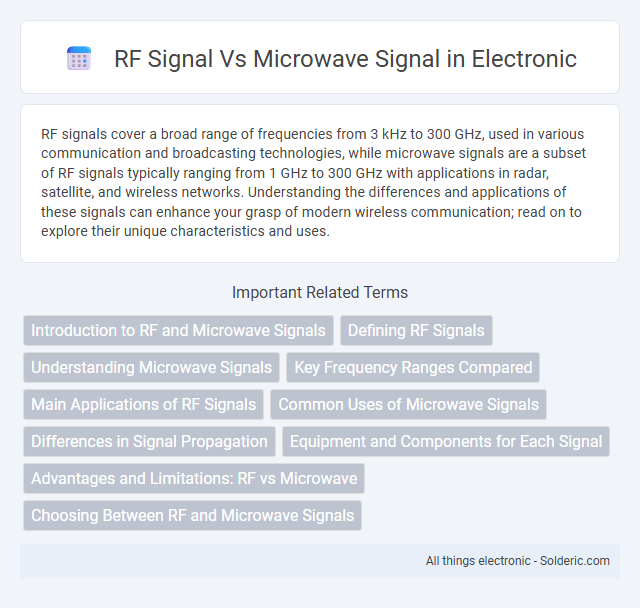RF signals cover a broad range of frequencies from 3 kHz to 300 GHz, used in various communication and broadcasting technologies, while microwave signals are a subset of RF signals typically ranging from 1 GHz to 300 GHz with applications in radar, satellite, and wireless networks. Understanding the differences and applications of these signals can enhance your grasp of modern wireless communication; read on to explore their unique characteristics and uses.
Comparison Table
| Feature | RF Signal | Microwave Signal |
|---|---|---|
| Frequency Range | 3 kHz to 300 GHz | 1 GHz to 300 GHz (subset of RF) |
| Wavelength | 1 km to 1 mm | 30 cm to 1 mm |
| Propagation | Ground, sky waves, line of sight | Primarily line of sight |
| Applications | Radio broadcasting, AM/FM, TV, radar | Satellite communication, radar, WiFi, Bluetooth |
| Penetration Ability | Better through obstacles and buildings | Limited penetration, affected by rain/fog |
| Bandwidth | Narrower bandwidth typically | Higher bandwidth, suitable for high data rates |
Introduction to RF and Microwave Signals
RF signals operate within the frequency range of 3 kHz to 300 GHz, encompassing a broad spectrum used for wireless communication, broadcasting, and radar systems. Microwave signals are a subset of RF signals typically spanning 1 GHz to 300 GHz, known for their short wavelengths that enable high data transfer rates and precise directional transmission. Both RF and microwave signals are fundamental in modern telecommunications, with microwaves favored for point-to-point communication and satellite links due to their ability to penetrate atmospheric conditions effectively.
Defining RF Signals
RF signals refer to electromagnetic waves within the frequency range of 3 kHz to 300 GHz, primarily used for wireless communication and broadcasting. These signals encompass various spectrum segments, including low-frequency bands for AM radio and higher frequencies overlapping with microwave signals for radar and satellite transmissions. Understanding RF signals involves recognizing their role in modulating information over radio frequencies that enable communication across different distances and applications.
Understanding Microwave Signals
Microwave signals are a subset of radio frequency (RF) signals with frequencies ranging from 1 GHz to 300 GHz, characterized by their short wavelengths and high-frequency capabilities. These signals enable high-capacity data transmission and are essential for applications such as satellite communication, radar systems, and wireless networks. Understanding microwave signals involves analyzing their propagation, attenuation factors, and interaction with atmospheric conditions to optimize signal strength and reliability.
Key Frequency Ranges Compared
RF signals typically range from 3 kHz to 300 GHz, encompassing low frequency bands used in AM radio and extending into the microwave spectrum. Microwave signals occupy the higher end of this spectrum, approximately from 1 GHz to 300 GHz, primarily utilized in radar, satellite communication, and wireless networking. The key frequency distinction lies in microwaves being a subset of RF, specifically targeting gigahertz frequencies that enable high data rate transmission and line-of-sight communication.
Main Applications of RF Signals
RF signals, ranging from 3 kHz to 300 GHz, are primarily used in wireless communication systems such as radio broadcasting, television transmission, and mobile networks. These signals facilitate wireless data transfer, RFID technology, and radar systems, allowing your devices to communicate effectively over various distances. In contrast, microwave signals, a subset of RF above 1 GHz, are often employed in satellite communication, point-to-point links, and microwave ovens due to their higher frequency and shorter wavelength.
Common Uses of Microwave Signals
Microwave signals are widely used in radar systems, satellite communications, and wireless networks due to their high frequency and ability to carry large amounts of data over long distances. These signals enable efficient point-to-point communication links, including cellular phone transmissions, Wi-Fi connections, and microwave ovens for heating food. Understanding your specific application helps optimize the use of microwave technology for faster and more reliable signal transmission compared to lower-frequency RF signals.
Differences in Signal Propagation
RF signals generally propagate over longer distances with lower frequencies, passing through obstacles like buildings and terrain more effectively than microwave signals. Microwave signals operate at higher frequencies, resulting in primarily line-of-sight transmission and greater susceptibility to atmospheric absorption and attenuation. Your choice between RF and microwave signals must consider these propagation characteristics to optimize communication range and reliability.
Equipment and Components for Each Signal
RF signal equipment primarily includes antennas, mixers, filters, and amplifiers designed to handle frequencies ranging from 3 kHz to 300 GHz, often used in communication systems and radar. Microwave signal components are specialized for higher frequencies within the RF spectrum, typically 1 GHz to 300 GHz, featuring waveguides, microwave cavities, and high-frequency oscillators to ensure signal integrity and minimal loss. Your choice of equipment depends on the specific frequency range and application, with microwave systems requiring more precise components to manage shorter wavelengths and higher energy.
Advantages and Limitations: RF vs Microwave
RF signals offer broad coverage with lower infrastructure costs, making them ideal for long-range communication, but they suffer from limited bandwidth and susceptibility to interference. Microwave signals provide high bandwidth and directional transmission, enabling faster data rates and reduced interference, yet they require line-of-sight and are sensitive to weather conditions. The choice between RF and microwave depends on application requirements such as range, data rate, and environmental factors.
Choosing Between RF and Microwave Signals
Choosing between RF and microwave signals depends on the application frequency range and required signal propagation characteristics. RF signals typically operate below 3 GHz, offering better penetration through obstacles and longer range, making them suitable for mobile communication and broadcasting. Microwave signals, operating above 3 GHz, provide higher data rates and directional capabilities ideal for radar, satellite communication, and point-to-point links.
RF signal vs microwave signal Infographic

 solderic.com
solderic.com